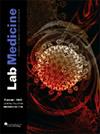葡萄糖和糖化血红蛋白
IF 1
4区 医学
Q4 MEDICAL LABORATORY TECHNOLOGY
引用次数: 9
摘要
葡萄糖是一种单糖,是人体能量的主要来源。它被肝脏和其他细胞用作能量或作为糖原储存起来供以后使用。血液中的葡萄糖水平是由胰岛素和胰高血糖素两种胰腺激素调节的。当葡萄糖水平升高时,胰岛素就会释放出来。胰岛素的作用是增加糖生成、脂肪生成和糖酵解,导致血液中葡萄糖的减少。当葡萄糖水平下降时,胰高血糖素被释放,导致肝脏将储存的葡萄糖(糖原)释放到血液中(糖原溶解),从而增加血液中的葡萄糖水平。糖化血红蛋白(HbA1c),也称为糖化血红蛋白,是葡萄糖与血红蛋白分子上的氨基反应形成酮胺时产生的一种血红蛋白化合物。葡萄糖分子附着在正常成人血红蛋白β-多肽链的一个或两个n端缬氨酸上糖化血红蛋白的形成与血糖浓度成正比。由于红细胞的平均寿命约为120天,糖化血红蛋白水平反映了前2至3个月的平均血糖水平。葡萄糖测试是用来确定一个人是否有高血糖或低血糖。空腹血糖水平高(≥126 mg/dL)和/或HbA1c水平高(>6.5%)可能表明患者患有糖尿病。HbA1c是监测糖尿病长期控制的可靠方法;它确定了一个人在大约3个月的时间里的平均血糖水平。正常取值范围为4.0% ~ 6.0%。一项研究结果2表明,平均血糖水平与糖化血红蛋白水平之间存在很强的线性关系。目前美国糖尿病协会的指南建议,对正在接受治疗的患者每年至少进行两次糖化血红蛋白检测。[[1]]E-mail: vfreeman{at} utmbb.edu [1]: #xref- correspondence -1-1本文章由计算机程序翻译,如有差异,请以英文原文为准。
Glucose and Hemoglobin A1c
Glucose, a monosaccharide, is the primary source of energy for the human body. It is used by the liver and other cells for energy or stored as glycogen for later use. The level of glucose in the bloodstream is regulated by 2 pancreatic hormones, insulin and glucagon. Insulin is released when glucose levels rise. Insulin acts by increasing glycogenesis, lipogenesis, and glycolysis, causing a decrease of glucose in the bloodstream. Glucagon is released when glucose levels fall, causing the liver to release stored glucose (glycogen) into the bloodstream (glycogenolysis), thereby increasing the level of glucose in the bloodstream.
Hemoglobin A1c (HbA1c), also called glycosylated hemoglobin, is a hemoglobin compound produced when glucose reacts with the amino group on a hemoglobin molecule forming a ketoamine. The glucose molecule is attached to one or both N-terminal valines of the β-polypeptide chains of normal adult hemoglobin.1 The HbA1c formation is proportional to the blood glucose concentrations. Because the average red blood cell life is approximately 120 days, the glycosylated hemoglobin level reflects the average blood glucose level during the previous 2 to 3 months.
Glucose testing is used to determine if an individual has hyperglycemia or hypoglycemia. A high fasting glucose level (≥126 mg/dL) and/or a high HbA1c level (>6.5%) might indicate that an individual has diabetes mellitus.
HbA1c is a reliable method of monitoring long-term diabetes mellitus control; it determines the average blood glucose level of an individual during a period of approximately 3 months. Normal values range from 4.0% to 6.0%. Results of a study2 have shown the strong linear relationship between average blood glucose levels and HbA1c levels. Current American Diabetes mellitus Association guidelines recommend that a HbA1c test be performed at least twice yearly on patients who are meeting treatment …
[↵][1]* To whom correspondence should be addressed. E-mail: vfreeman{at}utmb.edu
[1]: #xref-corresp-1-1
求助全文
通过发布文献求助,成功后即可免费获取论文全文。
去求助
来源期刊

Labmedicine
医学-医学实验技术
CiteScore
2.50
自引率
0.00%
发文量
155
审稿时长
>12 weeks
期刊介绍:
Lab Medicine is a peer-reviewed biomedical journal published quarterly by the ASCP and Oxford University Press. The journal invites submission of manuscripts on topics related to clinical chemistry and microbiology, hematology, immunology, transfusion medicine, molecular diagnostics, cytology, histology, and laboratory administration and management. Original research, reviews, and case reports are considered for publication. Lab Medicine is indexed (under the title Laboratory Medicine) by the National Library of Medicine and is included in the PubMed database.
 求助内容:
求助内容: 应助结果提醒方式:
应助结果提醒方式:


